Drug abuse (substance misuse): definition, causes, effects, prevention, treatment, and commonly abused substances
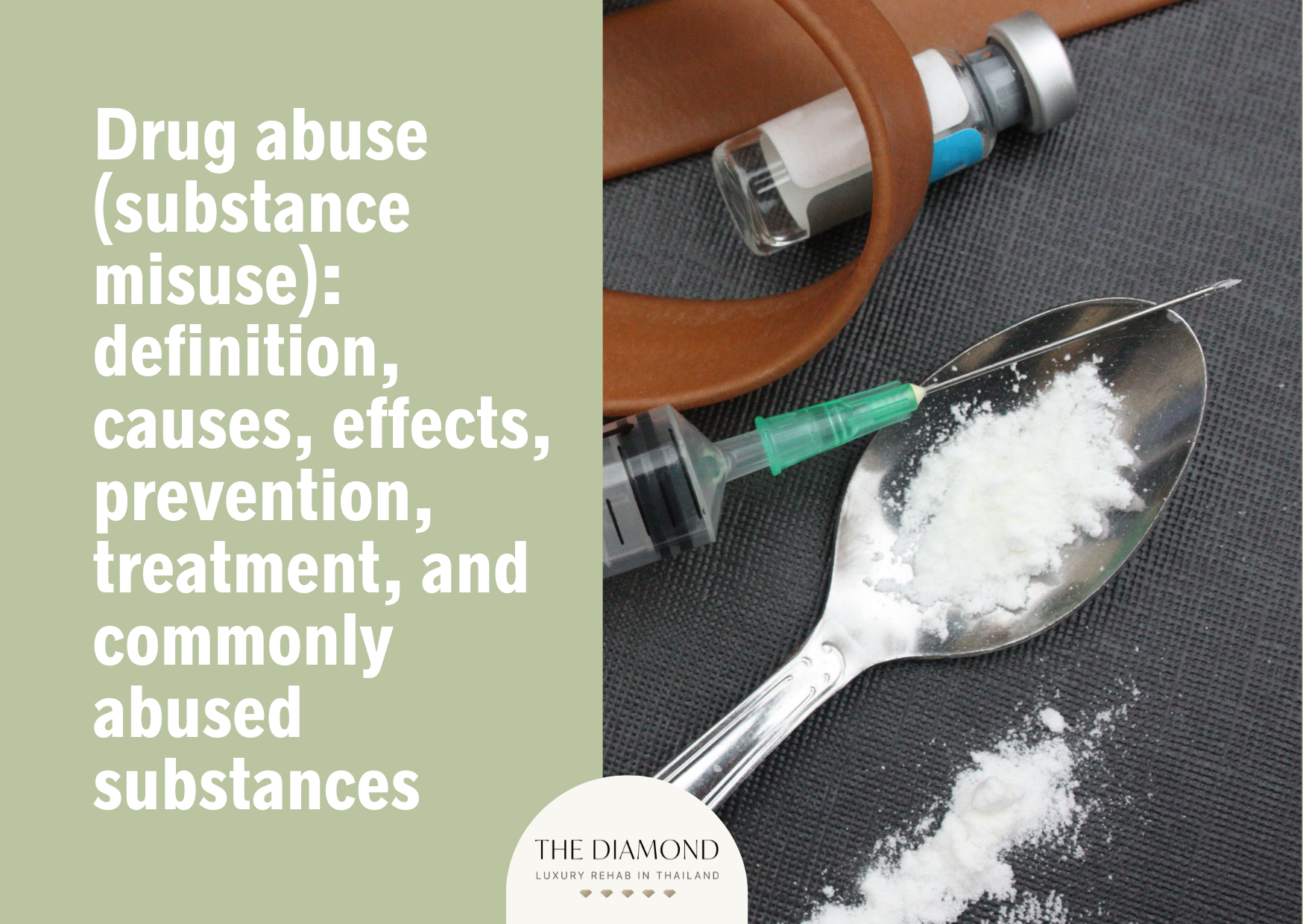
Drug abuse (substance misuse) describes the dangerous or damaging use of psychoactive substances, such as illegal drugs and alcohol. It frequently entails utilizing a substance in unintended or unprescribed manners, resulting in health, psychological, or social detriment.
The causes of drug misuse include experimental use of substances in social situations, absence of consistent family support or a stable home life, genetic predisposition, exposure to ongoing environmental pressure, socioeconomic status, and mental health conditions.
The effects of drug misuse are changes in appetite and weight loss, mental health problems, lung or heart disease, stroke, cancer, mental confusion, strained relationships, legal and financial trouble, isolation and loss of social connection, and risk of overdose and death.
The prevention of drug abuse (substance misuse) is done by being proactive in educating people, understanding the risks, and fostering supportive settings in communities and families.
Treatments for substance abuse include detoxification, behavioral therapy, medication-assisted treatment (MAT), support groups, family therapy, and ongoing treatment.
The most commonly abused substances are alcohol, cannabis (marijuana), cocaine, heroin, methamphetamine, prescription opioids (e.g., oxycodone, hydrocodone), inhalants, and benzodiazepines (e.g., Xanax, Valium).
What is drug abuse (substance misuse)?
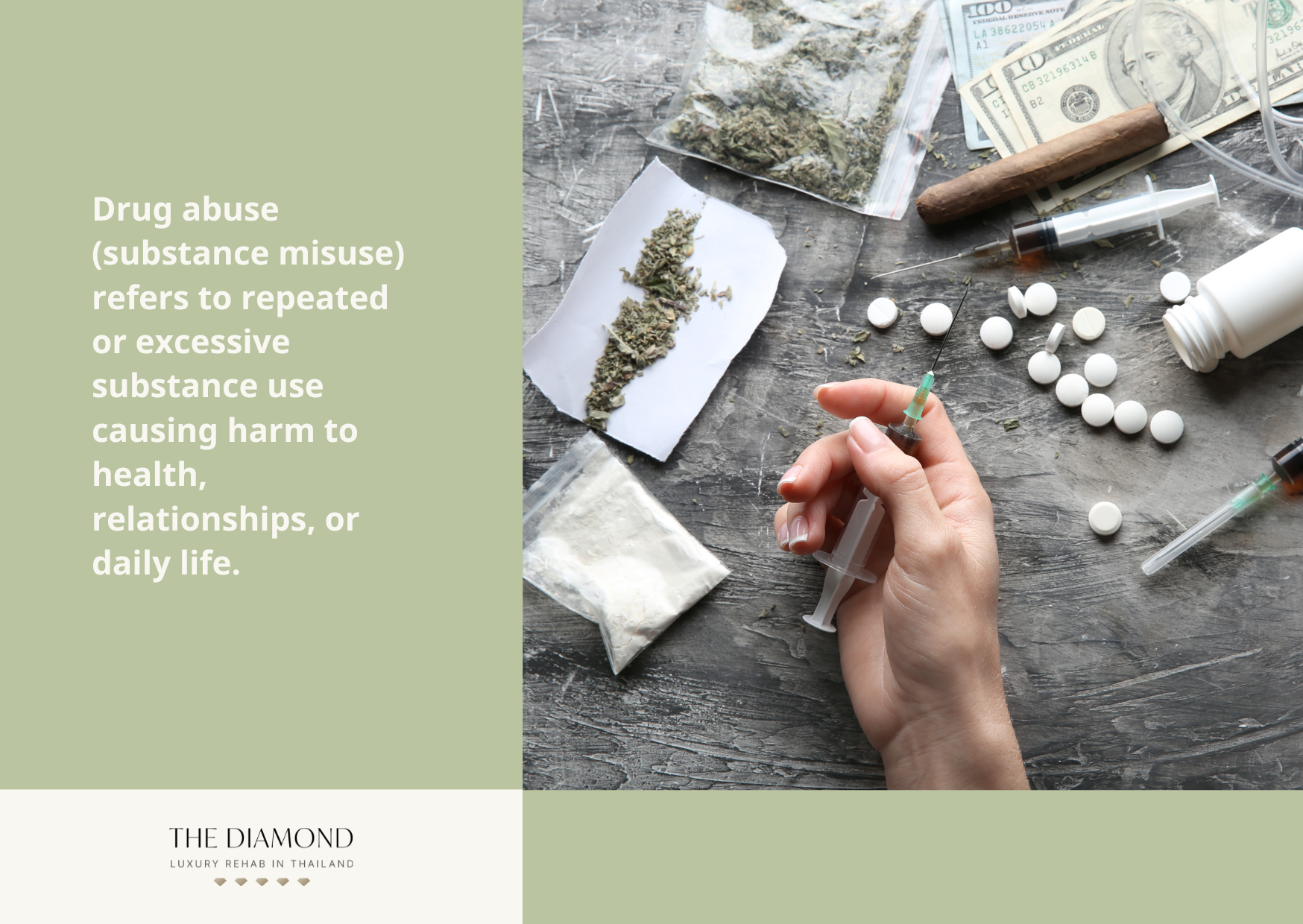
Drug abuse (substance misuse) refers to repeated or excessive substance use causing harm to health, relationships, or daily life. This includes the use of illegal drugs, misused prescribed medications, or consuming legal substances in unsafe amounts or for unintended purposes.
Problems with brain chemistry, including impaired ability to regulate emotions, impulses, and decisions, are common with such abuse patterns. Compulsive behavior and an elevated risk of psychological and physiological problems are long-term outcomes.
According to the 2020 substance abuse statistics from the National Center for Drug Abuse Statistics (NCDAS), 59.277 million or 21.4% of Americans aged 12 years and older have abused prescription medications or used illegal drugs within the past 12 months.
When does substance use become substance abuse?
Substance use becomes substance abuse when a person loses the ability to control how much or how often they use a drug. Even with a desire to cut down or stop, use continues despite awareness of the harm caused.
Drug misuse turns into abuse once responsibilities at work, school, or home begin to suffer. Relationships suffer due to arguments, neglect, or broken trust linked to the person’s behavior. Health problems—both physical and mental—often begin to appear or worsen with continued use.
Risky actions, such as driving while intoxicated or mixing substances, become more common. The person spends a large amount of time obtaining, using, or recovering from the drug.
What is the difference between drug abuse and drug addiction?
The difference between drug abuse and drug addiction lies in the level of control, intensity, and impact on daily life. Drug abuse is a milder form of substance-related problems involving harmful patterns of use without complete loss of control.
A person engaging in abuse uses substances recreationally or in risky situations but still manages certain responsibilities. Although harmful, drug abuse does not always bring about physical dependence or an inability to regulate usage.
Various individuals who abuse drugs are still able to stop or cut back when needed. However, repeated abuse increases the risk of progressing to a more serious condition. A severe kind of substance use disorder, drug addiction is characterized by compulsive drug-seeking and persistent usage in spite of negative effects.
Withdrawal symptoms, intense cravings, and significant alterations in brain function are common manifestations of the condition. The drug addiction and drug abuse difference becomes clear when drug use shifts from being a choice to a necessity.
What are the causes of drug misuse?
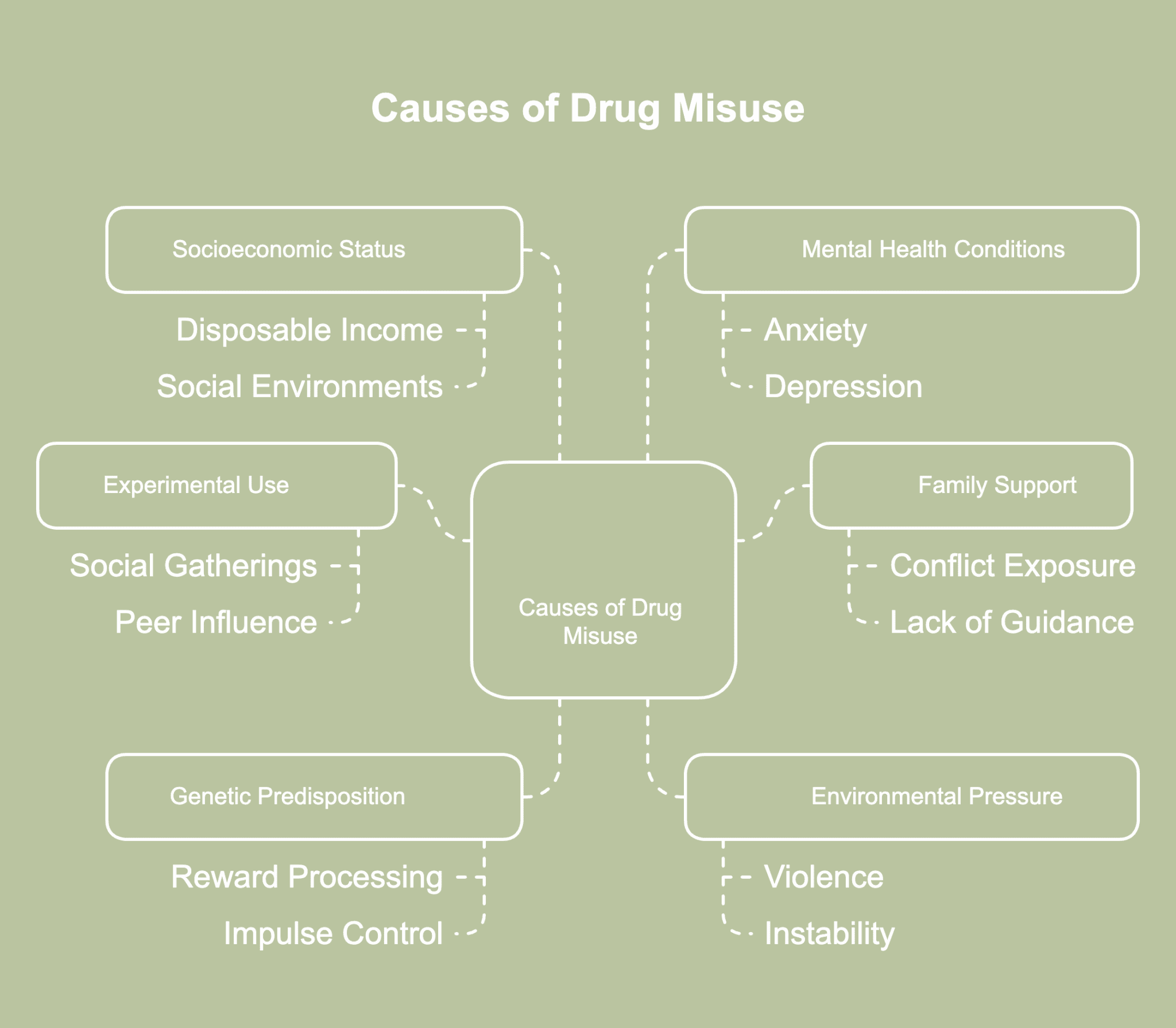
Causes of drug misuse denote the fundamental elements driving individuals to engage in harmful or improper substance usage. The causes of drug misuse are listed below.
- Experimental use of substances in social situations: Experimental drug use often begins in social settings where individuals feel encouraged to try something new to enhance the experience or blend in with the group. The relaxed atmosphere at such gatherings reduces inhibitions, allowing a person to justify trying a substance “just once.” What starts as experimentation in a relaxed environment slowly leads to repeated use, especially when the experience feels enjoyable or rewarding. Social drug use, though seemingly harmless at first, sometimes becomes the first step toward more frequent and harmful patterns of substance misuse.
- Absence of consistent family support or a stable home life: Growing up in an unstable household leaves emotional gaps people attempt to fill through drug use. Constant exposure to conflict, neglect, or lack of guidance pushes a person to seek comfort or escape. Without a nurturing support system, making healthy choices becomes increasingly difficult. Difficult circumstances tend to weaken emotional resilience, making drug misuse a more likely coping method.
- Genetic predisposition: Genetic vulnerability plays a significant role in how the brain responds to substances, influencing the risk of dependency. According to a 2021 paper by Joseph D. Deak and Emma C. Johnson titled “Genetics of substance use disorders: a review,” the discovery of common genetic risks for alcohol, tobacco, and cannabis use disorders raises the possibility that certain biological pathways, like ones related to reward processing or impulse control, predispose people to several SUDs (substance use disorders).
- Exposure to ongoing environmental pressure: Living in a high-stress environment—such as areas with violence, instability, or constant uncertainty— increases the urge to escape through substance use. People surrounded by chronic stress turn to drugs as a temporary relief from mental overload. Over time, stress becomes a trigger reinforcing continued misuse. The body and mind, under constant tension, begin to associate drugs with relief and control.
- Socioeconomic status: Contrary to common assumptions, drug use among adolescents does not only occur in disadvantaged settings and is influenced by various social and economic factors. A 2021 study by Aschengrau et al., titled “Influence of Family and Community Socioeconomic Status on the Risk of Adolescent Drug Use” referenced previous research demonstrating elevated family SES (socioeconomic status) correlates with a heightened risk of adolescent drug use, contradicting the prevalent notion of lower SES being a more significant risk factor. Supplemental studies corroborate the finding, indicating drug use is more common among adolescents from higher SES households due to easier access to resources such as disposable income and social environments.
- Mental health conditions: Mental health disorders such as anxiety, depression, or post-traumatic stress disorder (PTSD) often lead to self-medication with drugs. Instead of seeking therapy or support, affected individuals attempt to dull symptoms with substances offering quick, but harmful, relief. Drug misuse in such cases becomes a way to manage overwhelming feelings or emotional pain. Self-medicating worsens both the mental condition and the addiction, creating a destructive cycle.
What are the effects of drug misuse?
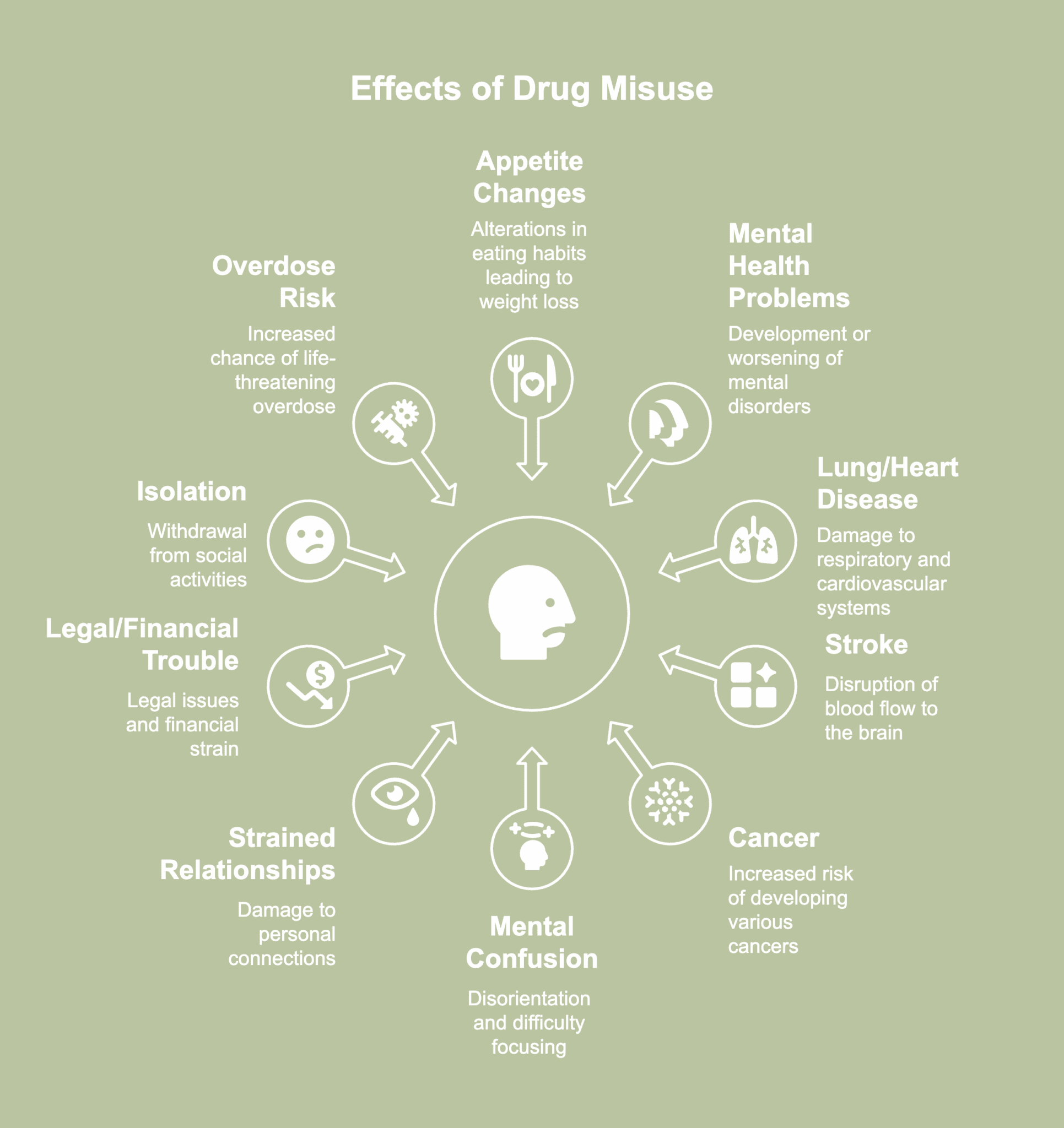
Effects of drug misuse describe the various negative consequences arising when substances are used in ways that disrupt normal functioning. The effects of drug misuse are listed below.
- Changes in appetite and weight loss: Drug dependence alters appetite, either increasing or suppressing it depending on the substance used. Individuals skip meals or forget to eat for extended periods, leading to noticeable weight loss and nutritional deficiencies. Over time, the body weakens from a lack of essential nutrients, making everyday tasks more exhausting. Malnourishment eventually affects organ function, immunity, and overall appearance, further impacting health.
- Mental health problems: Illicit drug use frequently contributes to the development or worsening of mental health disorders. An individual begins to feel detached from reality, experience mood swings, or lose motivation for daily tasks. Psychological effects linger even after drug use stops, requiring long-term treatment or therapy.
- Lung or heart disease: Certain substances, especially those smoked or inhaled, strain the lungs and reduce oxygen flow throughout the body. Stimulants like cocaine or methamphetamines place immense pressure on the heart, increasing the risk of irregular rhythms or heart attacks. In a 2019 report by Nishimura et al., titled “The Impact of Substance Abuse on Heart Failure Hospitalizations,” substance misuse is a common and critical concern among people with heart failure, impacting 15.2% of the cohort. The increased incidence of ischemic heart disease, cerebrovascular accidents, and endocarditis in the group likely indicates the cardiotoxic effects of substances such as cocaine (causing ischemia and stroke) and methamphetamine (associated with cardiomyopathy and pulmonary hypertension).
- Stroke: Chemical abuse drastically raises blood pressure and disrupts normal circulation, setting the stage for a stroke. Clotting, narrowed arteries, or sudden changes in heart rate block blood flow to the brain, prompting brain cell death. After a stroke, individuals struggle with speech, mobility, or memory, depending on the area affected.
- Cancer: Long-term exposure to illicit substances—especially compounds containing toxic chemicals or carcinogens—increase the likelihood of developing cancer. The risk rises significantly for cancers of the lungs, liver, mouth, or throat depending on the method of use. According to a study by Kale et al., published in February 2025, titled “Care for patients with cancer and substance use disorders: a qualitative study of oncology team experiences,” patients with SUDs are less likely to receive opioid medication for cancer-related pain, resulting in poorly managed symptoms and suffering. Compared to patients without SUDs, those with cancer and SUDs frequently experience less favorable outcomes, increased healthcare usage, and higher mortality rates.
- Mental confusion: Substance dependence disrupts brain function, leading to moments of disorientation, forgetfulness, or difficulty focusing. A person loses track of conversations, forgets appointments, or struggles with basic tasks once considered simple. Confusion tends to worsen during withdrawal or when drugs are used in combination, leaving the mind in a fog.
- Strained relationships: Harmful substance use tends to damage trust between friends, partners, and family members. Communication breaks down, especially when lies, financial problems, or mood shifts create tension. Loved ones feel neglected, hurt, or resentful, leading to emotional distance or complete disconnection. Repairing personal relationships requires time, effort, and professional support.
- Legal and financial trouble: Possession, use, or sale of illegal substances leads to arrests, fines, or even imprisonment. Legal battles and court fees quickly drain savings or place families under financial stress. Additionally, money is diverted from essentials like food or rent to support one’s drug habit.
- Isolation and loss of social connection: Addictive drug behavior causes withdrawal from friends, hobbies, and meaningful activities. A person avoids social situations out of shame, fear of judgment, or the desire to keep using without interference. Eventually, the isolation deepens, leaving the individual without support or positive interaction. Loneliness then becomes another burden, feeding the cycle of unregulated drug use.
- Risk of overdose and death: Using large doses or mixing drugs increases the chance of a life-threatening overdose. Breathing slows, heart function stops, or the body shuts down entirely without warning. Emergency intervention does not always succeed, especially if help arrives too late. Each episode places a person closer to irreversible harm.
How does drug abuse affect the brain?
Drug abuse affects the brain in multiple damaging ways, gradually disrupting normal function and structure. Particularly in regions of the brain involved in emotion, behavior, and decision-making, substances alter the way brain cells interact.
The brain’s reward system is affected when people use drugs, causing an overabundance of dopamine and subsequently strong pleasurable emotions. The brain becomes addicted to repeated use due to the artificial chemical surge promoting the behavior.
The brain then adapts by lowering natural dopamine levels, leading to reduced satisfaction from everyday activities. Memory and learning suffer as brain areas linked to focus and retention become impaired. In certain cases, overuse of drugs induces brain damage, affecting both cognitive function and emotional control.
Severe misuse induces seizures due to abnormal electrical activity in the brain. Recovery usually takes time, as the brain must relearn how to function without chemical interference.
What are the long-term effects of drug abuse?
The long-term effects of drug abuse include dental health problems, liver damage, infectious diseases like human immunodeficiency virus (HIV) and hepatitis B and C, as well as a higher likelihood of dying from self-inflicted harm, violence, or unintentional injury.
Substances such as methamphetamines erode enamel, cause gum disease, and result in tooth loss in time. The liver, responsible for filtering toxins, becomes overwhelmed by constant drug exposure, leading to scarring, inflammation, or failure.
Sharing needles or engaging in unsafe practices during drug use increases the chance of contracting HIV and bloodborne illnesses like hepatitis B and C. Such infections tend to progress silently but eventually produce lasting damage to the immune system and liver.
Mental health declines as well, and in certain cases, chronic drug use triggers suicidal thoughts or behaviors. Addicted individuals under the influence act aggressively or impulsively, raising the risk of involvement in violent situations. Impaired coordination, slowed reaction time, and poor judgment frequently lead to accidents, including car crashes or falls.
How is drug abuse (substance misuse) prevented?
Drug abuse (substance misuse) is prevented by taking proactive steps to understand the risks, educate others, and create supportive environments within families and communities. One important approach is to talk honestly about drugs, their effects, and the long-term consequences of misuse.
Reducing stigma and encouraging people to seek counsel before problems arise are both aided by open conversations. People learn to identify risky habits and make better choices with the help of education, which is particularly important when initiated at an early point in school.
Families providing structure, emotional support, and clear expectations reduce the chances of drug experimentation. Communities additionally contribute by offering programs, resources, and safe spaces keeping people engaged and connected.
Knowing the triggers—such as stress, peer pressure, or trauma—helps individuals avoid situations leading to misuse. When one understands personal risk factors, the likelihood of developing healthy coping strategies increases.
Prevention requires continuous effort from multiple sources rather than a one-time solution. With consistent guidance and support, the risk of improper drug use is significantly lowered.
What are the treatments for substance abuse?
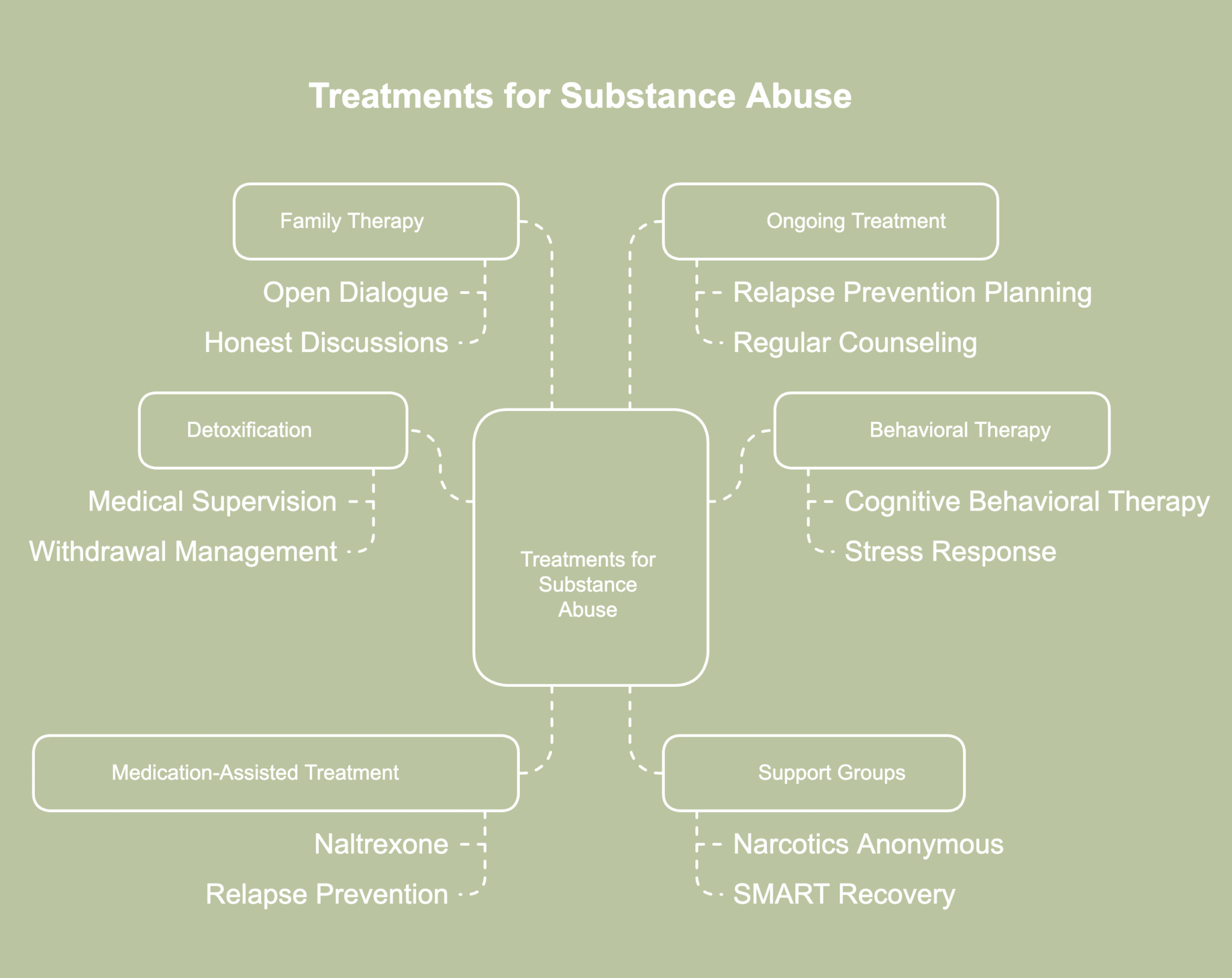
Treatments for substance abuse are various interventions designed to help individuals stop using harmful substances and improve overall functioning. The treatments for substance abuse are listed below.
- Detoxification: Detox is often the first step in treatment, helping the body eliminate harmful substances while managing withdrawal symptoms. The process must be supervised by medical professionals, especially when dealing with alcohol, opioids, or other drugs causing physical dependence. Detox is potentially dangerous without proper guidance, as sudden cessation triggers seizures or severe health issues. Clearing the system prepares individuals for the next stages of recovery with greater physical stability.
- Behavioral therapy: Therapies like cognitive behavioral therapy (CBT) focus on identifying harmful patterns and teaching healthier responses to stress or cravings. According to a 2023 review by Magill et al., titled “Efficacy of Cognitive Behavioral Therapy for Alcohol and Other Drug Use Disorders: Is a One-Size-Fits-All Approach Appropriate?” CBT is a recognized intervention for alcohol and other drug use disorders (AOD), exhibiting significant efficacy in comparison to limited treatment controls (such as pamphlets or waitlists) and standard care controls.
- Medication-assisted treatment (MAT): Medication is sometimes prescribed to reduce cravings, ease withdrawal symptoms, or block the effects of drugs. MAT is most commonly used for opioid or alcohol misuse and must be combined with counseling or therapy for best results. United States Food and Drug Administration (US FDA)-approved medications like naltrexone help restore chemical balance in the brain disrupted by compulsive substance use. When administered properly, MAT reduces relapse risk and improves treatment retention.
- Support groups: Group-based recovery programs like Narcotics Anonymous or SMART Recovery provide connection, accountability, and shared experience. Being around others who understand the struggle fosters a sense of community and helps sustain motivation. Stories of setbacks and success inspire members to continue working toward sobriety.
- Family therapy: Family therapy helps repair relationships damaged by addiction and encourages healthier interactions at home. Sessions involve open dialogue, guided exercises, and honest discussions about each member’s role in the recovery journey. Family therapy (FT) was found to be associated with substantial improvements in family functioning and reductions in substance use in numerous studies, as noted in a 2022 paper by Esteban et al., titled “Effects of family therapy for substance abuse: A systematic review of recent research.”
- Ongoing treatment: Ongoing treatment supports recovery after initial programs have ended, helping individuals maintain progress and adjust to everyday life. Continued care includes relapse prevention planning, regular counseling, or check-ins with professionals. For many, knowing the triggers to using illegal substances is crucial in avoiding setbacks.
What are the most commonly abused drugs?
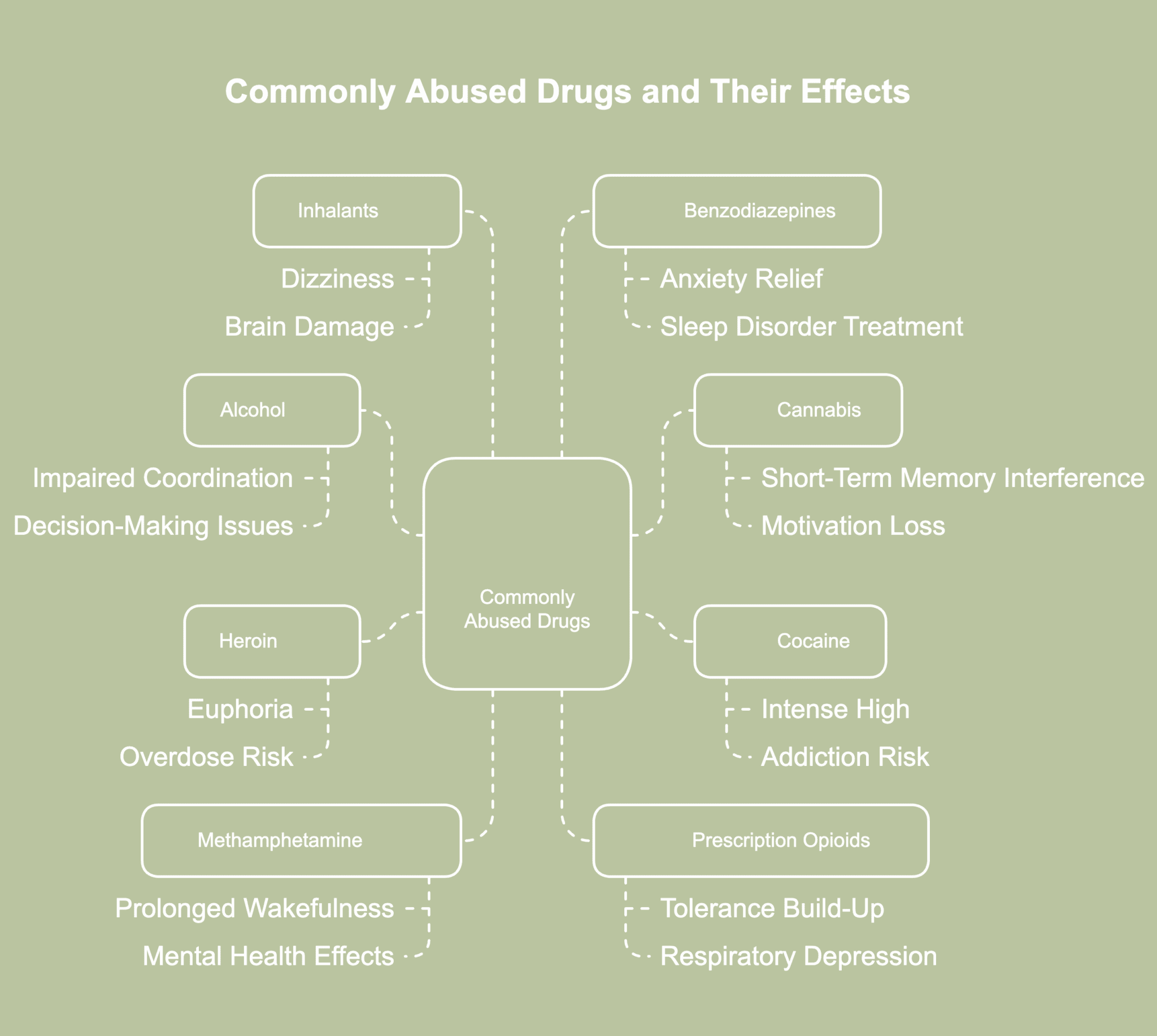
Most commonly abused drugs refer to substances frequently misused due to the ability to produce pleasurable effects, alter mood or perception, or relieve pain. The most commonly abused drugs are listed below.
- Alcohol: Alcohol is one of the most widely available substances used recreationally despite its high potential for misuse. Excessive drinking impairs coordination, decision-making, and long-term brain function. Dependence tends to develop gradually, especially when used to cope with stress or emotional pain.
- Cannabis (marijuana): Cannabis remains popular among users because of the relaxing and euphoric sensations the substance produces. Frequent use interferes with short-term memory, motivation, and concentration, especially in younger individuals. Although certain nations have legalized the drug for medical or recreational use, misuse still leads to dependency in certain cases.
- Cocaine: Cocaine acts as a powerful stimulant, producing an intense yet brief high. The strong urge to use more after each high leads to a high risk of addiction. According to a publication by John R. Richards and Jacqueline K. Le titled “Cocaine Toxicity” last updated in June 2023, cocaine misuse constitutes a significant public health issue, with around 20 million users globally, based on the latest United Nations World Drug Report.
- Heroin: Heroin, an illegal opioid, causes an intense rush of euphoria followed by deep drowsiness. Users inject heroin, increasing the risk of infectious diseases through shared needles. Overdose is common, especially when mixed with other depressants or contaminated substances. The drug falls under the category of Schedule I drugs due to heroin’s high potential for abuse and lack of medical use.
- Methamphetamine: Methamphetamine, or meth, produces an intense rush and prolonged wakefulness. Methamphetamines are highly addictive and quickly lead to compulsive use. Long-term abuse damages the skin, teeth, and internal organs while severely affecting mental health. Violent behavior and hallucinations are common among chronic users.
- Prescription opioids (e.g., oxycodone, hydrocodone): Medications originally intended for pain relief give rise to misuse when taken in larger amounts or without a prescription. Tolerance builds over time, pushing users to increase doses or seek stronger alternatives. Respiratory depression from opioid overuse is fatal. Prescription opioids have become one of the most commonly abused drug types in recent years.
- Inhalants: Inhalants include substances like glue, paint thinners, and aerosol sprays, known for producing mind-altering effects when inhaled. Such products attract young users because of easy availability and low cost. Short-term effects include dizziness, hallucinations, and loss of coordination, while long-term use results in brain damage and sudden death. Despite being legal household items, misuse of inhalants poses serious health risks and is often overlooked in discussions about substance abuse.
- Benzodiazepines (e.g., Xanax, Valium): Benzodiazepines are sedatives prescribed to treat anxiety or sleep disorders but are frequently misused for the calming effects they produce. Controlling negative affective states (such as anxiety or insomnia) is the most frequent reason for abusing benzodiazepines, especially in women, according to a 2019 report by Votaw et al., titled “The epidemiology of benzodiazepine misuse: A systematic review.” More problematic use, such as co-ingestion with other substances, greater doses, non-oral administration (e.g., injection), and unlawful purchasing, is linked to recreational purposes (e.g., to get high).

